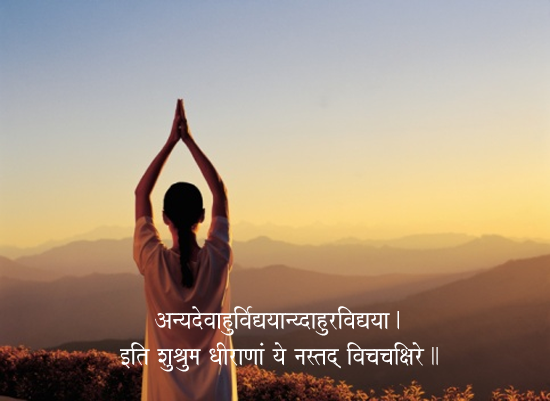Dec 16, 2025
Dec 16, 2025

Anyad–evahur–vidyaya anya–dahur–avidyaya,
iti susruma dhiranam ye nastad vica–caksire (10 )
The two notions –Vidya and Avidya
as popularly assumed,
grant different gains, serving varying interests
as is experienced and explained by common people.
Commentary
Vidya and Avidya; Knowledge and not knowledge or ignorance both are but concepts. We are required to drop off these two on the path of spiritual journey to Eternity. The real, unreal and the admixture of the two are all but notions and naught else. The notions or concepts are neither real nor unreal.
What then we call real in this universe?
For this, we have to go beyond mind because unreal world has acquired substantiality on account of the persistence of this notion of its existence. Thus all beings sustain such notion out of their own concepts and ideas. The seer does not explain his own experience but that of the people. The verse contains opinion of the common people. For them Vidya and Avidya both have their own utility; the fruits may differ though.
To the Avidya wedded person life seems to be real, the world of senses is real. On the other hand to a person wedded to the pursuit of Vidya, the world of spirit is the real world. Each one calls the other as a dreamer but a synthesis of both is essential for a harmony in life of this world of action and karma.
Avidya stands for nescience. Generally the concept is related to physical world of beings and their activities of life existence. When consciousness is identified with mind and thus with brain, and does not remain as spiritual cosmic principle apart from mind, it is Avidya in the extreme. Avidya is something related to non-spiritual and physical world of action. It is connected with our daily life and human welfare. Vidya may be related to the truth of the metaphysical world just as chemistry and the other natural sciences deal with the truth of physical world.
An illustration for the common peoples understanding is suggested. The whole universe seems like a picture on screen. The poster of the picture may be useful and alluring but it has no sense unless the picture is shown on the screen, The screen itself is without any use unless it shows the picture on it. So neither the picture nor the screen is of any worth even though they serve some purpose.
Such is the case with Vidya and Avidya. The Avidya, given to physical world of action can be worthwhile only in connection with Vidya, the supreme knowledge of Brahman. Avidya or physical sciences are no good enough to be sufficient for achieving the highest Bliss without the self –knowledge of the Infinite In easy term, we can say that science and spirituality have to go together, integrated and coordinated. Such is also the case with Vidya, it imparts pure knowledge and if exclusively pursued, it is thus a mental exercise only. The mind being inert, does not touch the Self. Vidya and Avidya, both being concepts have to be left out on way of Self-Enquiry into Eternity...Avidya may account for pelf and position as all good works result in satisfaction of the doer and bring him name and fame, but the fact is that such a man also feels inwardly a void even in this surrounding and remains away from real Self. On the other hand, the Vidya –wedded man remains in his own dream world of ego and intellectual superiority and consequently loses his equipoise and tranquillity.
Vidya and Avidya are both stations on the road map and serve some guiding purpose but the train to Eternity has to leave these stations on its journey to the supreme destination. Some people have interpreted Vidya as Devata jnana as it leads to the abode of Devata whichever one propitiates. Avidya is the performance of ritual with a motive. Avidya is Karma and it leads to certain goal of life. Some saints believe that it is by good karmas, one reaches Pitraloka. From there after enjoying results of good fruits, one is reborn in the world. The saints think that by meditation and upasana, one reaches Pitraloka (manes )and from there proceeds either to world or to the Supreme. Anyway it seems to be an orthodox opinion, no more valid this day.
Previous: Isha Upanishad - Shloka 9
Next: Isha Upanishad - Shloka 11
Image (c) Gettyimages.com
30-Apr-2011
More by : Dr. R. K. Lahri